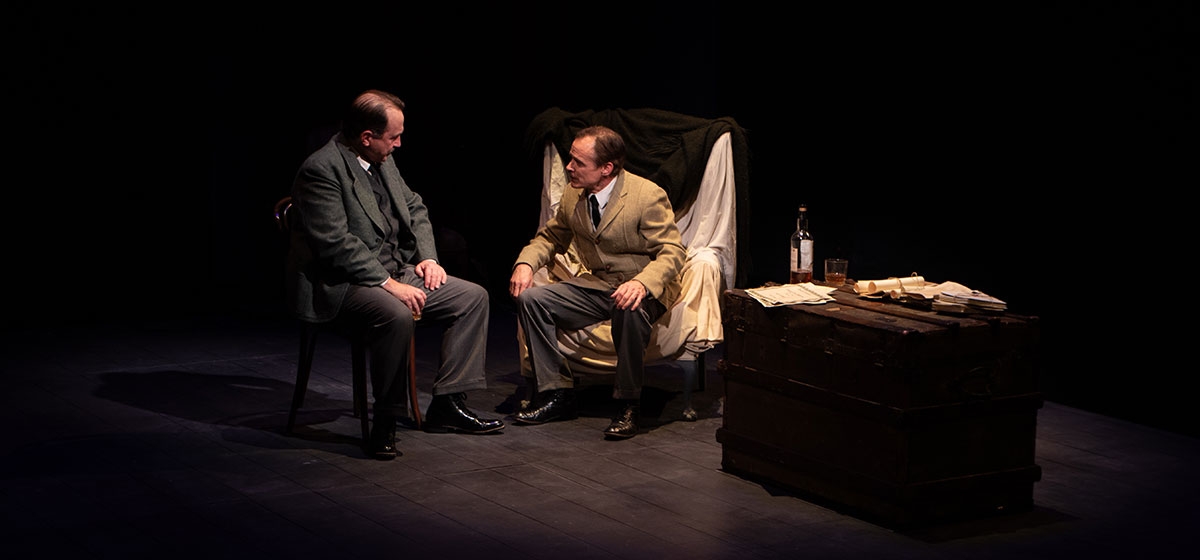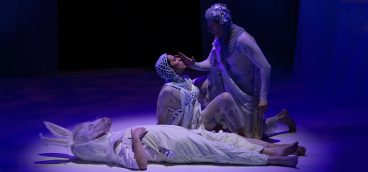
“The Woman in Black” is one of those rare creations, like “One Flew Over the Cuckoo’s Nest,” that has found success in multivarious forms as a novel, play, and film. Based on Susan Hill’s 1983 book, PICT Classic Theatre’s production uses Stephen Mallatratt’s 1987 adaptation (an unusually safe bet for this company that even wrote its own version of “Oedipus Rex”) which became one of the longest-running non-musical shows in London’s West End history.
Although PICT’s marketing materials describe the production as “spine-chilling, terrifying, classic, theater,” the first two adjectives are somewhat misleading, as what is presented is more of an exercise in consummate acting than proverbial scaring. There are only two players: Martin Giles (Mr. Kipps) and James FitzGerald (The Actor), and they happen to be two of the strongest thespians in Pittsburgh; thank God, because this is really a play about actors, not ghosts.
They assume virtually all the roles, jump-cutting through time to fill in the backstory, changing costumes and accents when necessary, and even evoking the imaginary elements that cannot be acted, like a dog that sinks into a moor. Giles and FitzGerald deliver a minimalist but powerfully symbiotic performance on a relatively bare stage—imagine Samuel Beckett and Harold Pinter being forced to collaborate on an early 20th-century gothic tale, and this is what you would get.
Mallatratt’s version—a two-hour retelling of Hill’s novel that adds a play-within-the-play conceit—comes off as adequate but underwhelming: it’s like a stiff, archaic jacket the actors are forced to wear which limits their mobility. There isn’t much humor, or variation to the tone, and it incorporates so much self-narration—the actors describing what they’re doing, instead of just doing what they’re doing—that at times it feels like one of those improv acting classes where you have to invent a scene and play all the parts yourself. But Giles and and FitzGerald can really stretch the seams of the dramatic cloth they’re given.
Alan Stanford’s direction keeps the action humming as it scuttles between present and past, with Mr. Kipps recounting a tragic story that has haunted his family for much of his life. He’s being “directed” so to speak by the other character, The Actor, as the elaboration evolves into reenactment. It can get very confusing watching them constantly change costumes and personae, but Stanford gives us the option to just sit back and let it all wash over us. It’s kind of like what Howard Hawks did with his film adaptation of “The Big Sleep”—if you try to follow it too closely you’ll become lost. But, as he rightly surmised, who cares about the details?
Costume designer Joan Markert’s adroit wardrobe choices help us follow the time-shifts, when there is nothing else to guide the audience like set changes or make-up adjustments. For example, when we see The Actor slip on a Norfolk jacket, we immediately know we have been thrust into Edwardian times from the original 1930s setting.
As lighting designer, Keith A. Truax also carries much of the burden for a show that relies on the spectral for its success. His backlighting techniques are a simple and effective way to give entrée to the haunted dimensions of the stage, and set us up for the impact of Nick DePinto’s disturbing sound effects.
Catherine Kolos provides the very proficient stage management, assisted by Karen Baum, who also serves as the uncredited Woman in Black, a ghoulish, non-speaking role that she has reprised masterfully for PICT many times.
Near the end of the play, Mr. Kipps says, “Let us go on,” and one can’t help but notice the resonance with the last line of “Waiting for Godot,” when Estragon says, “Yes, let’s go.” Just as scary stories haunt us, so do strong prior works of theatre, and this is a production that deeply relishes its own dramatic ghosts.
“The Woman in Black” continues through Nov. 23, Fred Rogers Studio at WQED, 4802 Fifth Ave., Oakland, $15-48. 412-561-6000 or www.picttheatre.org.





